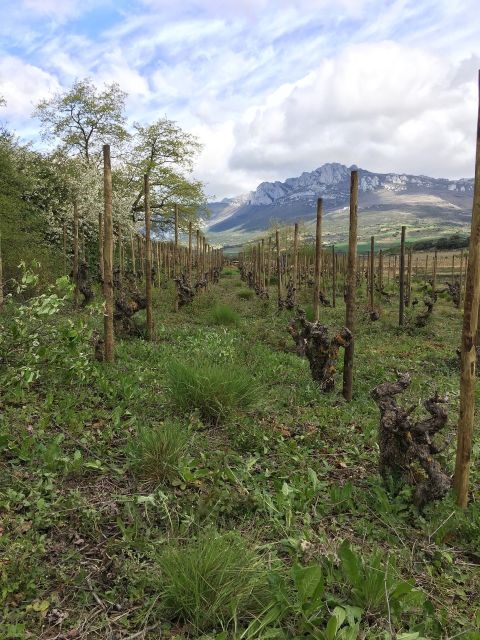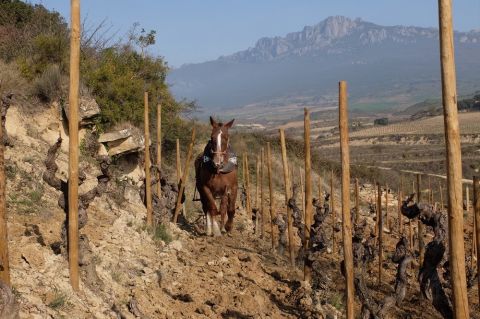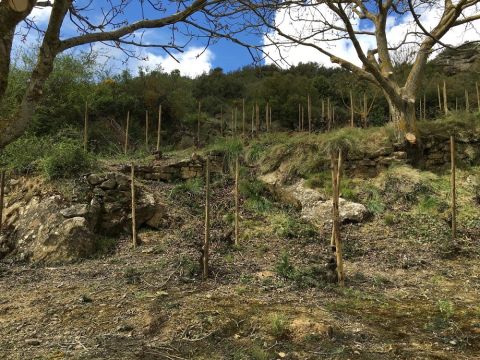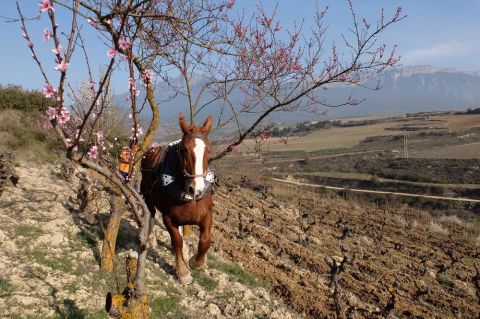The serendipity of San Julián
After biking around vineyard trails, my husband David, a vine-grower, arrived home ecstatic about an abandoned vineyard he had found scaling a ravine in the valley referred to as San Julián which sits between our village in Elvillar and the neighbouring village of Laguardia. It was May and the vines were not pruned which provoked him to start poking around and inquiring about its status. While a small parcel, it had three separate owners, all of whom were planning on ripping up the old vines and using the rights to replant in a flat location better fitted for conventional farming. David insisted on showing me his discovery. Together we had very little liquidity, but he knew I had money set aside to pay taxes in the United States. I had recently cashed out my life savings to purchase another vineyard I had fallen in love with in our village and by doing so I would face penalties for early withdrawal. Thinking there was no way I – a transplant in Rioja – would invest in another parcel, I accompanied him to see the vineyard.
Accessing the vineyard was not easy. A very bumpy and washed-out road winding around the side of the hill leads to a narrow and steep trail to gain entrance to the vines themselves. The other entrance is available by accessing a lower vineyard road with stairs that lead to a small hiking trail winding up to the top of the hill. Both entrances are a variant of the Camino Ignaciano trail indicated by markers running through the side of the vineyard. In the times of modern agriculture, the spirit of Ignaciano’s walking trail was congruent. It is said that Ignacio crossed many pilgrims flowing in the opposite direction. He said we must be attentive to callings that lead us “against the current” of popular opinion and fashion. This vineyard was the antitheses of modern farming.
The entrance alone was a clear indicator of why the previous owners were planning on tearing up the vineyard and using the rights to plant in a more convenient location. Every step in this vineyard requires manual labour inaccessible by tractor. A human or animal must do the work. It was serendipity as we had eliminated tractors from our vineyards in 2014. Plow horses could help us bring life back to this steep and unloved parcel.
It was as if the vineyard had been hidden for years in its own ecosystem, rich with life and far from the monoculture that too often surrounds us. There were more than 20 trees planted throughout, albeit a bit overgrown, that my first description was we had entered into a fairy garden. You could see the remains of labyrinth rock walls that were built to separate the various sections. Huge boulders that could not be moved insisted on standing their ground, forcing mankind to work with nature rather than dominating it. And vines showing the same fortitude emerging from the base of the rocks with a bold determination. A picture of a time that too often is lost or forgotten; in modern times we are quick to ignore the wisdom of the past in exchange for convenience and monetary reward. The vineyard was a snapshot of history from the region; locals say it’s what Rioja Alavesa looked like 100 years ago. When biodiversity was more abundant as it was necessary. They lived and ate from the vines, fruit, and nut trees. Every inch of land was revered and precious. The vineyard itself was isolated from its neighbours by a rambling brush forest, a perfect location for a biodynamic vineyard, free from cross-contamination. In the far corner of the vineyard lay the remains of a guardaviñas, a historical structure in the likes of a stone igloo, used as a refuge for the farmers. Relics from a time gone by.
Needless to say, it didn’t take convincing. I fell in love and decided to use the remainder of my savings to acquire the land. The purchase wasn’t easy as we had to stop a transaction – relocating the rights – and gain agreement from three different families to sell. Fortunately, we knew someone in the local governing body who was willing to put us in contact with the previous owners. He joked it was his repentance from so many years of executing contrary transactions to encourage people to replant such vineyards.
Over the years we’ve tried to bring the vineyard back to its full splendour. We pruned the trees and now enjoy vineyard peaches, quince, cherry, pears, and walnuts in addition to the vines. Over time we will work on the aesthetics and rebuild the walls and guardaviñas but these are costly items that will have to wait for the moment.
Like all vineyards, it has taken time to get to know her. The east-facing orientation led us to believe that the grapes would be light and elegant, and one of the last to harvest due to a significant amount of afternoon shade. Alas, she has produced quite the contrary. This is one of the very first vineyards we harvest every year and the grapes produce wine with structure and character.
In our region, an indicator of the age of a vineyard is the diverse type of vines planted. Upon our first inspection, we noticed a wide range of varieties but many could not be identified so we brought in the Director of the Department of Agricultural Investigation from the Madrid Institute of Investigation (IMIDRA). He and his team confirmed that the larger subset of vines was Tempranillo but many vines were unknown by sight alone. They were listed as Rare Tempranillo until they conduct a DNA analysis from the extracted samples. Other interesting varieties found were Moscatel Rojo, Tinta Velasco, a rare small bunch Moscatel, Cabernet Sauvignon and a Rare Graciano. Why these were planted and how they were obtained will remain a mystery.
We bud-grafted some unwanted Jaen in a small section of the vineyard to save the original vine and grow a different variety in its place. We carefully selected clippings from two of the vineyard's rare varieties, Cabernet Sauvignon and Graciano. Once again Ignacio's metaphor applied to our work as finding a skilled grafter for vines was not easy. It is a time-consuming technique that requires patience and practice.
The century-old vines of San Julián were planted in the early 1900s. Many of which are healthier than vines planted in the 1970s and 80s. These changes relate to a time when production and modern farming were truly taking hold. Horses were sold in exchange for tractors, vine growers purchased new vines from nurseries to ensure yield, chemicals were sold as revolutionary in agriculture, vineyards rows were widened and planted to accommodate ease of work vs. what was the best for the vineyard. Much of the soul was lost for a time. Thankfully, souls can be rescued and healed, especially if that soul was fortunate enough to start from a time when foresight was imperative for future generations. Back then money was scarce; tearing up and replanting was too costly for most vine growers. A life started without chemicals, stress, pruned in a way that ensured longevity. Unfortunately, few of my purchases are based on sound financial business decisions but I hope that by the time my children are old, they will walk the same vines with their children and feel that same soul, able to withstand generations, knowing that their parents walked the path of Ignacio while others passed in the opposite direction.
The photos are provided by Melanie Hickman



















